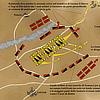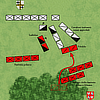

From the eleventh century began a strong revitalization in Europe, prepared for a long time: the strengthening of the internal exchanges and the strengthening of an economic expansion movement that did not arrests until the end of the thirteenth century, the attention paid by Carolingian culture, from the improvement of defense facilities in the tenth century, put an end to the long period of invasions and raids. The settling of the Hungarians and their conversion to Catholicism, flanked by that of the Czechs and the Poles, created a vast defensive barrier in front of the nomads of the steppes. Characterized the entire period, a substantial increase in population, which stimulated the clearing and cleaning of uncultivated areas, favored the creation of new villages, allowed the growth and multiplication of urban agglomerations, sharpened the material needs and the spirit of adventure of the aristocracy. The war enterprises, adapted to the tastes and education of the nobility, attracted the offspring, who sought to achieve in the most distant districts, their dreams of glory, booty, lands and men to be exploited: in the native regions benefits of war were limited by the institutions of peace and the processes of political-territorial consolidation.
At the military success of their ventures contributed the improvement of weapons and combat techniques, which was flanked by an educational system and a lifestyle of nobility that gave great importance to the courage, solidarity with the comrades in arms, the development of the body, the tournaments, the perfect mastery of the equestrian art: the eleventh century, the true soldier (miles) was the knight, equipped with heavier and effective weapons.
Another great movement of expansion of Western Christendom was created in the Iberian Peninsula, where many French knights in search of fortune, especially Burgundy, went to help the local princes in their attacks against the Muslim rulers. The struggle to re-conquer the territories occupied by infidels took on a more general meaning: it was interpreted by the Church of Rome as a holy war, as a meritorious work that ensured, the fighters, the salvation of their souls, and proposed a vent commendable aggressiveness of the knights. Since 1063, for example, Pope Alexander II granted indulgences and spiritual benefits to those who have participated in a military expedition against the valley of Ebrei, still Muslim.
The real crusade, preached by Pope Urban II in 1095, worried by the advance of the Seljuk sultanate of Konya or Rum (ie the Romans) in Asia Minor, was significantly different from the conduct holy war in the Iberian Peninsula. It was an armed pilgrimage, to the holy places, of warriors to which the papacy guaranteed the "immediate remission of sins". It gave life to some political domination that reflected the emerging feudal structures of the West. These latin principalities, however, were very fragile and were in fact kept alive by continuous inputs of the Western Warriors in place of the crusaders who purchased indulgences, they returned to Europe. Regardless of the great expeditions crusades, coordinated by the papacy in collaboration with major territorial domination, which were repeated from time to time and more and more wearily, the crusade was, therefore, a permanent institution.
The necessitate to protect the so weak principalities is also highlighted by the rise of special religious orders of a military nature, such as the Templar Knights and the Knights of St. John, who could also devote themselves to fight against the infidels in areas far removed from the holy places. It was the case of the Teutonic Knights who, initially dedicated to the care of the sick and turned into order of chivalry in 1198, between the thirteenth and fifteenth centuries imposed with fire and sword the faith of the church of Rome to the polytheistic peoples of Prussia, Livonia, Samogitia and Estonia and there created its own political domination by an elite line of efficient administrators chosen among the warrior-monks of the order.
Battles

25 November 1177
Near Ramla, in today's Israel, took place one of the most legendary battles of the Crusader kingdoms that saw two legendary figures of his time: Baldwin IV (the Leper King) and Saladin. Even today, not everyone remember that the young Baldwin IV was among the few, in history, to boast of clear successes on the field against the valiant Muslim leader. Montgisard is one of these.

4 July 1187
The Crusaders defeat decreed the end of the Kingdom of Jerusalem and the Islamic reconquest of much of Palestine.

May 18, 1190
The last triumph of Frederick Barbarossa took place in Asia Minor, during the Third Crusade. A few days after the victory against the Seljuks in front of the walls of Iconium, the German emperor drown in the river Saleph.

15 July 1410
The Teutonic Knights are defeated by the Polish-Lithuanian forces: it is the beginning of the end for the order.
| Home | Battles Index | Cartography | Chronology | Forum |